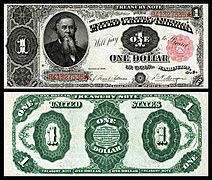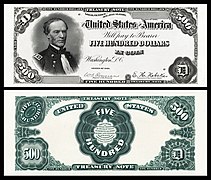Template:POTD/2022-08-28
-
$1: Edwin Stanton
-
$10: Philip Sheridan
-
$20: John Marshall
-
$50: William H. Seward
-
$100: David Farragut
-
$500: William Tecumseh Sherman
-
$1000: George Meade
The Treasury Note (also known as a Coin Note) was a type of representative money issued by the United States government from 1890 until 1893 to individuals selling silver bullion to the Treasury. A distinguishing feature of the 1890 series of Treasury Notes (and one that greatly appeals to collectors) is the extremely ornate designs on the reverse of the banknotes. It was intended to make counterfeiting much more difficult, but opponents argued that the extensive detail would make it more difficult to distinguish between genuine and counterfeit notes. Consequently, the designs for the reverse were simplified on the 1891 series of Treasury Notes, of which a complete set, comprising nine denominations from $1 to $1000, is pictured here. Each bears the engraved signatures of James Fount Tillman (Register of the Treasury) and Daniel N. Morgan (Treasurer of the United States), and a portrait of a different individual, as indicated above. The banknotes are part of the National Numismatic Collection at the Smithsonian Institution.Banknote design credit: Bureau of Engraving and Printing; scanned by Andrew Shiva









